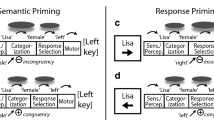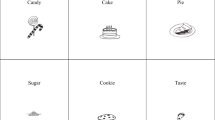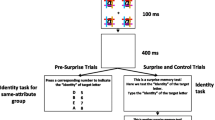Abstract
Long-term effects of cognitive conflict on performance are not as well understood as immediate effects. We used a change detection task to explore long-term consequences of cognitive conflict by manipulating the congruity between a changing object and a background scene. According to conflict-based accounts of memory formation, incongruent trials (e.g., a cow on the street), in spite of hindering immediate performance, should promote stronger encoding than congruent trials (e.g., a cow on a prairie). Surprisingly, across three experiments we show that semantic incongruity actually impairs remembering of the information presented during scene processing. This set of results is incompatible with the frequently accepted hypothesis of conflict-triggered learning. Rather, we discuss the present data and other studies previously reported in the literature in the light of two much older hypotheses of memory formation: the desirable difficulty and the levels of processing principles.


Similar content being viewed by others
Notes
From the original stimulus set, images displaying the exact same background scene (regardless of the target object) were removed and not used in this experiment to avoid recognition problems caused by image similarity.
Participants were instructed in the remember/know (RK) distinction (Rajaram, 1993) and, for OLD responses, they were asked to report whether their response was based on a feeling of remembering or on a feeling of knowing. Nevertheless, posterior analyses revealed that this distinction did not affect in any way the pattern of results and thus it will not be reported for this experiment, nor for any other experiment in the present study.
In a similar experiment run as a follow up of the present findings with a sample size of 36 participants we replicated the results from the study phase and the memory test with satisfactory significance levels (p < 0.05). Thus we can safely assume that equating the sample sizes from Experiment 3 to that of Experiment 1 will likely render the numerical differences found here statistically significant.
References
Bjork, R. A., & Bjork, E. L. (1992). A new theory of disuse and an old theory of stimulus fluctuation. In A. Healy, S. Kosslyn, & R. Shiffrin (Eds.), From learning processes to cognitive processes: Essays in honor of William K. Estes (Vol. 2, pp. 35–67). Hillsdale, NJ: Erlbaum.
Bjork, E. L., & Bjork, R. A. (2011). Making things hard on yourself, but in a good way: Creating desirable difficulties to enhance learning. In: Psychology and the real world: Essays illustrating fundamental contributions to society (pp. 56–64).
Botvinick, M. M., Braver, T. S., Barch, D. M., Carter, C. S., & Cohen, J. D. (2001). Conflict monitoring and cognitive control. Psychological Review, 108(3), 624–652.
Chiu, Y.-C., & Egner, T. (2014). Inhibition-induced forgetting: When more control leads to less memory. Psychological Science. doi:10.1177/0956797614553945.
Cousineau, D., & O’Brien, F. (2014). Error bars in within-subject designs: a comment on Baguley (2012). Behavior Research Methods, 46(4), 1149–51. doi:10.3758/s13428-013-0441-z.
Craik, F. I. M., & Lockhart, R. S. (1972). Levels of processing: A framework for memory research. Journal of Verbal Learning and Verbal Behavior, 11(6), 671–684. doi:10.1016/S0022-5371(72)80001-X.
Craik, F. I., & Tulving, E. (1975). Depth of processing and the retention of words in episodic memory. Journal of Experimental Psychology: General, 104(3), 268.
Crump, M. J. C., Gong, Z., & Milliken, B. (2006). The context-specific proportion congruent Stroop effect: Location as a contextual cue. Psychonomic Bulletin and Review, 13(2), 316–321. doi:10.3758/BF03193850.
de Winstanley, P. A., & Bjork, E. L. (1997). Processing instructions and the generation effect: a test of the multifactor transfer-appropriate processing theory. Memory (Hove, England), 5(3), 401–21. doi:10.1080/741941392.
de Winstanley, P. A., & Bjork, E. L. (2004). Processing strategies and the generation effect: Implications for making a better reader. Memory and Cognition, 32(6), 945–955. doi:10.3758/BF03196872.
Duthoo, W., Abrahamse, E. L., Braem, S., Boehler, C. N., & Notebaert, W. (2014). The heterogeneous world of congruency sequence effects: an update. Frontiers in Psychology, 5, 1001. doi:10.3389/fpsyg.2014.01001.
Egner, T. (2007). Congruency sequence effects and cognitive control. Cognitive, Affective, and Behavioral Neuroscience, 7(4), 380–390. doi:10.3758/CABN.7.4.380.
Egner, T., Ely, S., & Grinband, J. (2010). Going, going, gone: characterizing the time-course of congruency sequence effects. Frontiers in Psychology, 1(September), 154. doi:10.3389/fpsyg.2010.00154.
Eriksen, B. A., & Eriksen, C. W. (1974). Effects of noise letters upon the identification of a target letter in a nonsearch task. Perception and Psychophysics, 16(1), 143–149. doi:10.3758/BF03203267.
Gratton, G., Coles, M. G. H., & Donchin, E. (1992). Optimizing the use of information: Strategic control of activation of responses. Journal of Experimental Psychology: General, 121, 480–506.
Henson, R. N., & Gagnepain, P. (2010). Predictive, interactive multiple memory systems. Hippocampus, 20(11), 1315–1326. doi:10.1002/hipo.20857.
Hollingworth, A., & Henderson, J. M. (2000). Semantic informativeness mediates the detection of changes in natural scenes. Visual Cognition, 7(1–3), 213–235. doi:10.1080/135062800394775.
Hollingworth, A., Schrock, G., & Henderson, J. M. (2001). Change detection in the flicker paradigm: The role of fixation position within the scene. Memory and Cognition, 29(2), 296–304. doi:10.3758/BF03194923.
Kahneman, D. (1973). Attention and effort. Englewood Cliffs: Prentice-Hall.
Krebs, R. M., Boehler, C. N., De Belder, M., & Egner, T. (2013). Neural conflict-control mechanisms improve memory for target stimuli. Cerebral Cortex (New York, N.Y.: 1991). doi:10.1093/cercor/bht283.
Laming, D. R. J. (1968). Information theory of choice-reaction times. Academic Press.
LaPointe, M. R. P., Lupianez, J., & Milliken, B. (2013). Context congruency effects in change detection: Opposing effects on detection and identification. Visual Cognition, 21(January 2015), 99–122. doi:10.1080/13506285.2013.787133.
LaPointe, M. R. P., & Milliken, B. (2016). Conflicting effects of context in change detection and visual search: A dual process account. Canadian Journal of Experimental Psychology (in revision).
Luck, S. J., & Vogel, E. K. (1997). The capacity of visual working memory for features and conjunctions. Nature, 390(6657), 279–81. doi:10.1038/36846.
Peelen, M. V, & Kastner, S. (2014). Attention in the real world: toward understanding its neural basis. Trends in Cognitive Sciences, 1–9. doi:10.1016/j.tics.2014.02.004.
Petersson, K. M., Sandblom, J., Elfgren, C., & Ingvar, M. (2003). Instruction-specific brain activations during episodic encoding. NeuroImage, 20(3), 1795–1810. doi:10.1016/S1053-8119(03)00414-2.
Rajaram, S. (1993). Remembering and knowing: Two means of access to the personal past. Memory and Cognition, 21(1), 89–102. doi:10.3758/BF03211168.
Rensink, R. A., O’Regan, J. K., & Clark, J. J. (1997). To See or not to See: The Need for Attention to Perceive Changes in Scenes. Psychological Science, 8(5), 368–373. doi:10.1111/j.1467-9280.1997.tb00427.x.
Rescorla, R. A., & Wagner, A. R. (1972). A theory of Pavlovian conditioning: Variations in the effectiveness of reinforcement and nonreinforcement. In A. H. Black & W. F. Prokasy (Eds.), Classical conditioning II: Current research and theory (pp. 64–99). New York: Appleton-Century-Crofts.
Robertson, B. D., Hiebert, N. M., Seergobin, K. N., Owen, A. M., & MacDonald, P. A. (2015). Dorsal striatum mediates cognitive control, not cognitive effort per se, in decision-making: An event-related fMRI study. NeuroImage. doi:10.1016/j.neuroimage.2015.03.082.
Rosner, T. M., D’Angelo, M. C., MacLellan, E., & Milliken, B. (2014). Selective attention and recognition: effects of congruency on episodic learning. Psychological Research. doi:10.1007/s00426-014-0572-6.
Russo, J. E., & Dosher, B. A. (1983). Strategies for multiattribute binary choice. Journal of Experimental Psychology. Learning, Memory, and Cognition, 9(4), 676–696.
Simon, J. R., & Small, A. M. J. (1969). Processing auditory information: Interference from an irrelevant cue. J Appl Psychol.
Stirk, J., & Underwood, G. (2007). Low-level visual saliency does not predict change detection in natural scenes. Journal of Vision, 7, 1–10. doi:10.1167/7.10.3.Introduction.
Stroop, J. R. (1935). Studies of interference in serial verbal reactions. Journal of Experimental Psychology, 18(6), 643–662. doi:10.1037/h0054651.
Swallow, K. M., & Jiang, Y. V. (2010). The attentional boost effect: Transient increases in attention to one task enhance performance in a second task. Cognition, 115(1), 118–32. doi:10.1016/j.cognition.2009.12.003.
Torres-Quesada, M., Funes, M. J., & Lupiáñez, J. (2013). Dissociating proportion congruent and conflict adaptation effects in a Simon-Stroop procedure. Acta Psychologica, 142(2), 203–10. doi:10.1016/j.actpsy.2012.11.015.
Torres-Quesada, M., Milliken, B., Lupiáñez, J., & Funes, M. J. (2013). Proportion congruent effects in the absence of sequential congruent effects. Psicologica: International Journal of Methodology and Experimental Psychology, 35(1), 101–115. Retrieved from http://eric.ed.gov/?id=EJ1022043.
Tversky, B., & Sherman, T. (1975). Picture memory improves with longer on time and off time. Journal of Experimental Psychology: Human Learning and Memory, 1(2), 114.
van Kesteren, M. T. R., Rijpkema, M., Ruiter, D. J., & Fernández, G. (2010). Retrieval of associative information congruent with prior knowledge is related to increased medial prefrontal activity and connectivity. The Journal of Neuroscience: The Official Journal of the Society for Neuroscience, 30(47), 15888–15894. doi:10.1523/JNEUROSCI.2674-10.2010.
Verguts, T., & Notebaert, W. (2008). Hebbian learning of cognitive control: dealing with specific and nonspecific adaptation. Psychological Review, 115(2), 518–25. doi:10.1037/0033-295X.115.2.518.
Verguts, T., & Notebaert, W. (2009). Adaptation by binding: a learning account of cognitive control. Trends in Cognitive Sciences, 13(6), 252–7. doi:10.1016/j.tics.2009.02.007.
Zhang, L., Tong, M. H., Marks, T. K., Shan, H., & Cottrell, G. W. (2008). SUN: A Bayesian framework for saliency using natural statistics. Journal of Vision, 8(7), 32.1–20. doi:10.1167/8.7.32.
Author information
Authors and Affiliations
Corresponding author
Ethics declarations
Funding
This study was funded by the Spanish Ministerio de Economía y Competitividad with a research Grant to Juan Lupiáñez (PSI2014-52764-P).
Conflict of interest
The authors declare that they have no conflict of interest.
Ethical approval
All procedures performed in studies involving human participants were in accordance with the ethical standards of the institutional and/or national research committee and with the 1964 Helsinki declaration and its later amendments or comparable ethical standards.
Informed consent
Informed consent was obtained from all individual participants included in the study.
Rights and permissions
About this article
Cite this article
Ortiz-Tudela, J., Milliken, B., Botta, F. et al. A cow on the prairie vs. a cow on the street: long-term consequences of semantic conflict on episodic encoding. Psychological Research 81, 1264–1275 (2017). https://doi.org/10.1007/s00426-016-0805-y
Received:
Accepted:
Published:
Issue Date:
DOI: https://doi.org/10.1007/s00426-016-0805-y




